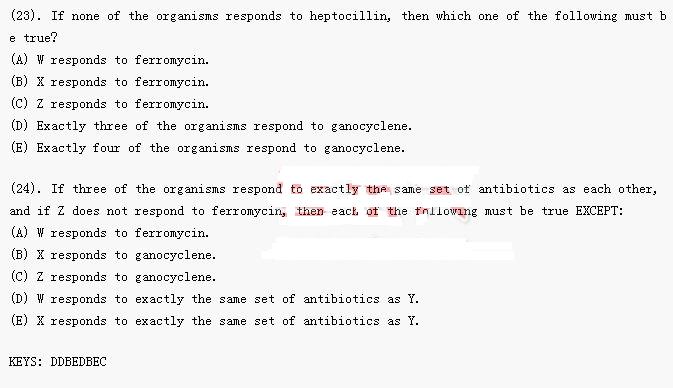7. Questions 18-24
The organisms W, X, Y, and Z respond to the antibiotics2 ferromycin, ganocyclene, and heptocillin in a manner consistent with the following:
Each of the organisms responds to at least one of the antibiotics.
No organism responds to all three antibiotics.
At least two but not all four of the organisms respond to ferromycin.
If W responds to any antibiotic1, then X responds to that antibiotic.
If an organism responds to ferromycin, then it responds to ganocyclene.
Y responds to ferromycin.
(18). Each of the following can be true EXCEPT:
(A) W responds to heptocillin.
(B) X responds to ganocyclene.
(C) X responds to heptocillin.
(D) Y responds to heptocillin.
(E) Z responds to ganocyclene.
(19). Which one of the following could be true?
(A) W, X, and Z all respond to ferromycin.
(B) W, X , and Z all respond to ganocyclene.
(C) W and exactly one other organism respond to ganocyclene.
(D) W responds to more of the antibiotics than X does.
(E) More of the organisms respond to ferromycin than to ganocyclene.
(20). Which one of the following could be true?
(A) Exactly one of the organisms responds to ferromycin.
(B) All four of the organisms respond to heptocillin.
(C) At least one of the organisms responds both to ferromycin and to heptocillin.
(D) At least one of the organisms responds neither to ganocyclene nor to heptocillin.
(E) At least one of the organisms responds to ganocyclene but does not respond to ganocyclene but does not respond to ferromycin.
(21). If X does not respond to ferromycin, then which one of the following must be true?
(A) W responds to ganocyclene.
(B) X responds to ganocyclene.
(C) X responds to heptocillin.
(D) Z responds to ferromycin.
(E) Z responds to heptocillin.
(22). If any of the organisms responds to two of the antibiotics, then which one of the following is true about such an organism?
(A) It must respond to ferromycin.
(B) It must respond to ganocyclene.
(C) It must respond to heptocillin.
(D) It cannot respond to ferromycin.
(E) It cannot respond to ganocyclene

 收听单词发音
收听单词发音 


